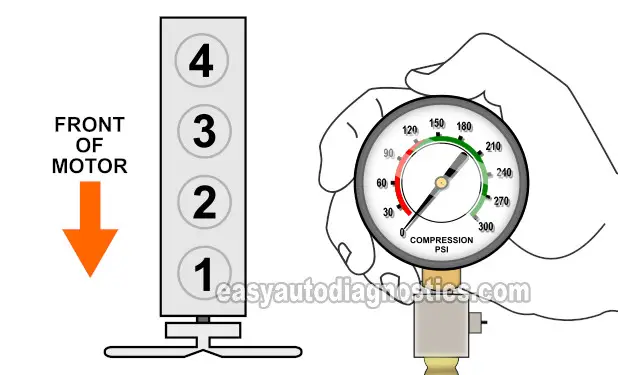TEST 2: Coolant Shooting Out Of Radiator

Another common consequence of head gasket failure is compression pressures leaking into the engine cooling system (which the radiator is a part of).
We can find out if this has happened by cranking the engine with the radiator cap off.
If one or both head gaskets are allowing combustion/compression pressures to enter the cooling system, you'll see the coolant in the radiator being forcefully pushed out.
IMPORTANT: Do not perform this test when the engine is hot! The coolant could be under high pressure and cause severe burns! Perform this test with a cold engine!
This is what you need to do:
- 1
Remove the radiator cap from the radiator.
IMPORTANT: The engine should be completely cold before you open the radiator cap. - 2
Check the coolant level.
If the coolant level is low, top it off with water before going on to the next step. - 3
Stand at a safe distance (from the engine) but within eye-view of the radiator.
- 4
Have your helper crank the engine.
- 5
You'll see one of two results:
1.) The coolant shoots out violently when the engine was cranked.
2.) The coolant was not disturbed at all.
Let's examine your test result:
CASE 1: The coolant shot out of the open radiator. This test result confirms that you have a blown head gasket or a warped/cracked cylinder head on your 3.0L Ford Ranger (Mazda B3000).
CASE 2: The coolant DID NOT shoot out of the open radiator. So far, so good.
In TEST 1 you confirmed that the coolant is not mixed with the engine oil. With this test you have confirmed that no exhaust gases escape through the radiator.
If the engine doesn't start, go to: TEST 3: Engine Compression Test.
If the engine starts but overheats, go to: TEST 4: Using A Chemical Block Tester (Combustion Leak Tester).
TEST 3: Engine Compression Test

In some cases, when the head gasket fails, a gap opens up in the head gasket between two adjacent cylinders.
When this happens, you'll have two dead cylinders, since the compression of one will leak into the other and vice versa. The end result is that those two side-by-side cylinders will have 0 PSI compression.
When this happens, you'll have two dead cylinders as the compression of one passes into the other and vice versa. The end result is that these two side-by-side cylinders have 0 PSI compression.
The photo at the beginning of this tutorial shows exactly this type of head gasket failure.
To check for this type of head gasket failure, you'll need to perform an engine compression test.
These are the test steps:
- 1
Disable the fuel system by removing the fuel pump relay to disable the fuel system.
- 2
Disable the ignition system by disconnecting both ignition coil packs from their connectors.
- 3
Remove the exhaust manifold side spark plugs only.
IMPORTANT: The intake manifold side spark plugs must remain in place on the engine. - 4
Install the compression tester (hand tight only) on the first cylinder you're gonna test.
- 5
Have a helper crank the engine while you observe the compression tester.
- 6
Have your helper stop cranking the engine once the needle on the gauge stops climbing.
- 7
Write down the compression readings.
- 8
Repeat steps 4 through 8 on the remaining cylinders.
Let's now take a look at your test result:
CASE 1: You have 2 adjacent cylinders at 0 PSI. This confirms beyond a doubt that you have a blown head gasket on your hands.
To be more specific, adjacent cylinders would be: #1 and #2 OR #2 and #3 OR just #3 and #4.
CASE 2: All cylinders had adequate compression. After running 3 tests you have confirmed that you do not have a blown head gasket on your 3.0L Ford Ranger or 3.0L Ford Mustang.

